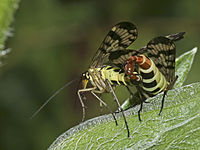|
Panorpa communis
Panorpa communis, the common scorpionfly,[1] is a species of scorpionfly. DistributionThis species is native to Europe (Italy, Switzerland, Germany, Austria, Czech Republic, Hungary, Slovakia, Ukraine, and European Russia)[2] and Northern Asia.[3][4][5] HabitatThese scorpionflies can be usually found in hedgerows and patches of nettle.[6] Description Panorpa communis can reach a body length of about 30 millimetres (1.2 in).[6] The common scorpionfly has a black and yellow body, with a reddish head and tail. The male has a pair of claspers at the end of its tail (for holding the female during mating),[6] giving it a scorpion-like appearance,[6] although it is not a stinger. The adult insect has a wingspan of about 35 millimetres (1.4 in),[6] with wings that are mostly clear, but have many dark spots or patches. Its head, mounted with large eyes, is drawn into a prominent, downward pointing beak,[6] which opens at the tip of its head. Females are longer, heavier, and have longer legs than males.[7] In the female, the eighth abdominal segment is the shortest, almost twice shorter than the seventh; the sixth is narrowed towards the back.[8] The larva resembles a caterpillar and grows up to 20 millimetres (0.79 in) long. It has three pairs of thoracic legs and eight pairs of prolegs.[9] Biology and habitsThe adult is seen between May and September.[6] They eat dead insects (although they sometimes eat live aphids), sometimes taking them from spider webs[6] and plant sap.[10] Although fully winged, the adults rarely fly very far and spend much of their time crawling on vegetation in damp, shaded places near water and along hedgerows. Panorpa communis is a univoltine species.[6] Eggs are laid in soil annually and the larvae both scavenge and pupate there.[6] Mating behaviorMales release pheromones and offer nuptial gifts to females in the form of saliva secretions and nuptial prey (usually dead arthropods).[11] Before offering the nuptial gifts, the male and female, perform ritualized premating behavior, which includes slow wing movements, accompanied by brief sequences of rapid vibrations from their abdomen.[11] The mating success of females increases with the size of nuptial gifts offered by the male.[11] Gallery
References
External links
|
||||||||||||||||||||||||||||||||||||






